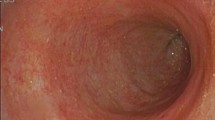Abstract
Background and aim
Narrow band imaging (NBI) is a novel endoscopy system, which enables a clear visualization of the mucosal vasculature of the gastrointestinal tract. The aim of this study is to determine whether this system may be of value for assessing the disease severity in ulcerative colitis (UC).
Materials and methods
We observed the mucosal vascular pattern (MVP) in 157 colorectal segments of 30 patients with UC using both conventional and NBI colonoscopy. The MVP was determined to be normal or distorted under conventional colonoscopy and, subsequently, to be clear or obscure under NBI colonoscopy. The histologic variables in each segment were assessed in biopsy specimen. The possible correlation between MVP and the histologic grade of inflammation was evaluated.
Results
The MVP under conventional colonoscopy was normal in 60 segments while it was distorted in 97 segments. In all of the former 60 segments, their MVP was clear under NBI colonoscopy. The MVP in the latter 97 segments were determined to be clear (n = 44) or obscure (n = 53) under NBI colonoscopy. Acute inflammatory cell infiltrates (26% vs. 0%, p = 0.0001), goblet cell depletion (32% vs. 5%, p = 0.0006), and basal plasmacytosis (2% vs. 21%, p = 0.006) were more frequently observed in segments with an obscure MVP than in those with a clear MVP.
Conclusion
NBI colonoscopy may be of value for determining the grade of inflammation in patients with quiescent UC.





Similar content being viewed by others
References
Gono K, Obi T, Yamaguchi M, Ohyama N, Machida H, Sano Y, Yoshida S, Hamamoto Y, Endo T (2004) Appearance of enhanced tissue features in narrow-band endoscopic imaging. J Biomed Opt 9:568–577
Gono K, Yamazaki K, Doguchi N, Nonami T, Obi T, Yamaguchi M, Ohyama N, Machida H, Sano Y, Yoshida S, Hamamoto Y, Endo T (2003) Endoscopic observation of tissue by narrowband illumination. Opt Rev 10:211–215
Nakayoshi T, Tajiri H, Matsuda K, Kaise M, Ikegami M, Sasaki H (2004) Magnifying endoscopy combined with narrow band imaging system for early gastric cancer: correlation of vascular pattern with histopathology. Endoscopy 36:1080–1084
Machida H, Sano Y, Hamamoto Y, Muto M, Kozu T, Tajiri H, Yoshida S (2004) Narrow-band imaging in the diagnosis of colorectal mucosal lesions: a pilot study. Endoscopy 36:1094–1098
Yoshida T, Inoue H, Usui S, Satodate H, Fukami N, Kudo S (2004) Narrow-band imaging system with magnifying endoscopy for superficial esophageal lesions. Gastrointest Endosc 59:288–295
Hamamoto Y, Endo T, Nosho K, Arimura Y, Sato M, Imai K (2004) Usefulness of narrow-band imaging endoscopy for diagnosis of Barrett’s esophagus. J Gastroenterol 39:14–20
Sumiyama K, Kaise M, Nakayoshi T, Kato M, Mashiko T, Uchiyama Y, Goda K, Hino S, Nakamura Y, Matsuda K, Mochizuki K, Kawamura M, Tajiri H (2004) Combined use of magnifying endoscope with a narrow band imaging system and a multibending endoscope for en bloc EMR of early stage gastric cancer. Gastrointest Endosc 60:79–84
Kara MA, Peters FP, Rosmolen WD, Krishnadath KK, ten Kate FJ, Fockens P, Bergman JJ (2005) High-resolution endoscopy plus chromoendoscopy or narrow-band imaging in Barrett’s esophagus: a prospective randomized crossover study. Endoscopy 37:929–936
Muto M, Katada C, Sano Y, Yoshida S (2005) Narrow band imaging: a new diagnostic approach to visualize angiogenesis in superficial neoplasia. Clin Gastroenterol Hepatol 3:S16–S20
Langholz E, Munkholm P, Davidsen M, Binder V (1994) Course of ulcerative colitis: analysis of changes in disease activity over years. Gastroenterology 107:3–11
Tibble JA, Sigthorsson G, Bridger S, Fagerhol MK, Bjarnason I (2000) Surrogate markers of intestinal inflammation are predictive of relapse in patient with inflammatory bowel disease. Gastroenterology 119:15–22
Riley SA, Mani V, Goodman MJ, Dutt S, Herd ME (1991) Microscopic activity in ulcerative colitis: what does it mean. Gut 32:174–178
Matsumoto T, Kuroki F, Mizuno M, Nakamura S, Iida M (1997) Application of magnifying chromoscopy for the assessment of severity in patients with mild to moderate ulcerative colitis. Gastrointest Endosc 46:400–405
Fujiya M, Saitoh Y, Nomura M, Maemoto A, Fujiya K, Watari J, Ashida T, Ayabe T, Obara T, Kohgo Y (2002) Minute findings by magnifying colonoscopy are useful for the evaluation of ulcerative colitis. Gastrointest Endosc 56:535–542
Nishio Y, Ando T, Maeda O, Ishiguro K, Watanabe O, Ohmiya N, Niwa Y, Kusugami K, Goto H (2006) Pit patterns in rectal mucosa assessed by magnifying colonoscopy are predictive of relapse in patients with quiescent ulcerative colitis. Gut 55:1768–1773
Seo M, Okada M, Yao T, Ueki M, Arima S, Okumura M (1992) An index of disease activity in patients with ulcerative colitis. Am J Gastroenterol 87:971–976
Rachmilewitz D (1989) Coated mesalamine (5-aminosalycylic acid) versus sulphasalazine in the treatment of active ulcerative colitis: a randomized trial. Br Med J 273:82–86
Powell-Tuck J, Day DW, Buckell NA, Wadsworth J, Lennard-Jones JE (1982) Correlation between defined sigmoidoscopic appearances and other measures of disease activity in ulcerative colitis. Dig Dis Sci 27:533–537
Matts SG (1961) The value of rectal biopsy in diagnosis of ulcerative colitis. Q J Med 30:393–407
Modigliani R (1994) Endoscopic management of inflammatory bowel disease. Am J Gastroenterol 89:53–65
Baron JH, Connell AM, Lennard-Jones JE (1964) Variation between observers in descending mucosal appearances in proctitis. Br Med J 5375:89–92
Blackstone MO (1984) Differentiation of ulcerative colitis from Crohn’s colitis. In: Blackstone MO (ed) Endoscopic interpretation: normal and pathologic appearance of the gastrointestinal tract. Raven, New York, pp 464–496
Author information
Authors and Affiliations
Corresponding author
Rights and permissions
About this article
Cite this article
Kudo, T., Matsumoto, T., Esaki, M. et al. Mucosal vascular pattern in ulcerative colitis: observations using narrow band imaging colonoscopy with special reference to histologic inflammation. Int J Colorectal Dis 24, 495–501 (2009). https://doi.org/10.1007/s00384-008-0631-9
Accepted:
Published:
Issue Date:
DOI: https://doi.org/10.1007/s00384-008-0631-9




